As football data continues to evolve, we’re seeing that most goal-scoring actions are produced with limited time in possession and few passes. With the emerging trend of quick, direct actions towards goal, top coaches are looking for ways to force the opposition into low losses.
At this point, most are aware that Jürgen Klopp’s Liverpool averaged 7.81 seconds of possession and an average of 2.51 passes en route to a UEFA Champions League title. The Champions League average of 12.50 seconds and 3.89 passes per goal-scoring action are indicators that most goals are the result of mistakes in the defensive and middle third or quick counterattacks.
With the game moving away from the “death by a thousand passes” approach, the new challenge is to create attacking conditions that mirror that average goal statistics. One of the re-emerging trends is man-marking in a high press.
In this tactical analysis, we’ll engage in a deep analysis of this philosophy, examining the objectives, set up and cues. As with all tactical models, analysis of what can go wrong and the solutions to get out of trouble are also explored.
Re-entries and baiting
Given the large number of re-entries per game, preparing the defensive tactics for opposition goal kicks, deep free kicks and throw-ins are an important means of gaining an edge. As apply man-marking tactics in their attacking third, one of the most important concepts you’ll notice is the desire to make the goalkeeper or a centre-back the playmaker. While many modern goalkeepers are very strong with their feet, effective pressing teams can still force critical errors. When team man-mark in the high press, they’re eliminating all short options. If the goalie or centre-back looks high up the pitch, if he even has the time to do so, he’ll notice the opposition is usually plus one at the back. The remaining options are intermediate-range passes. The players offering this outlet are under heavy pressure, so the pass and first touch have to be perfect to keep possession. That’s easier said than done.
One of the reasons is that high pressing teams use the intermediate options to bait the opponent into pressing traps. Since dead-ball situations allow the defending team to start from a highly structured set up, the onus is on the attacking team to solve the press and beat the trap. A common tactic among teams that man-mark in the high press is to give the wider options some space. That said, someone is always close enough to quickly close the gap, especially since the path to that player generally requires a flighted ball. Those passes are time-consuming and are quickly pressured. With few teams willing to take that risk, it’s common to see the attacking team play centrally before playing wide. On the flip side, that’s exactly what the defensive team wants. Funnelling play centrally, especially with intermediate and long-range passes better suits the more compact shape of the defence.
With the intermediate and long-range passes offering low-percentage outlets, the first few passes generally go short. As pressure builds on the centre-backs and goalkeepers, the defending team readies itself to intercept the progressive pass. Some of the best man-marking, high press teams thrive in this situation. For example, Bayern Munich easily paces the Bundesliga with 63% possession and ranks second in passes per defensive action with a statistic of 7.54. The Bavarian side wants to win the ball back as quickly as possible, keeping the ball in the opposition half. Since Bayern is so dominant in possession, it has the fewest interceptions in the Bundesliga (891). Winning the ball immediately after a turnover and keeping possession are the clear priorities for the club.
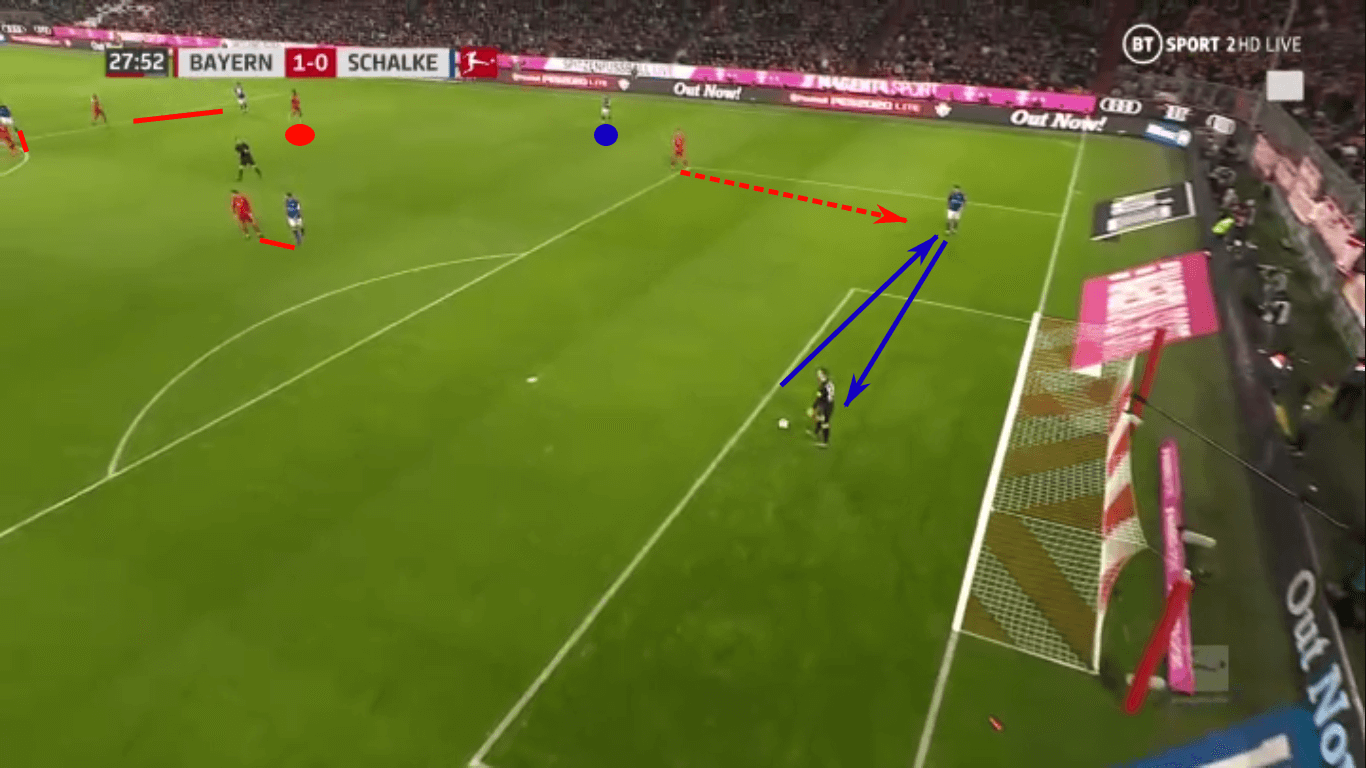
In Bayern Munich 5-0 home thrashing of Schalke, the man-marking high press was employed, including during Schalke goal kicks and any deep re-entry. Schalke goalkeeper, Markus Schubert, was left with two options. First, risk a pass to Jonjoe Kenny, one that safely cleared the presence of Ivan Perišić, but also allowed Kenny to play around the pressure of Alphonso Davies. Second, play short to one of the centre-backs, which is ultimately what he decided, sending the pass to Ozan Kabak. The pass to Kabak was returned to Schubert as Perisic pressured the defender.
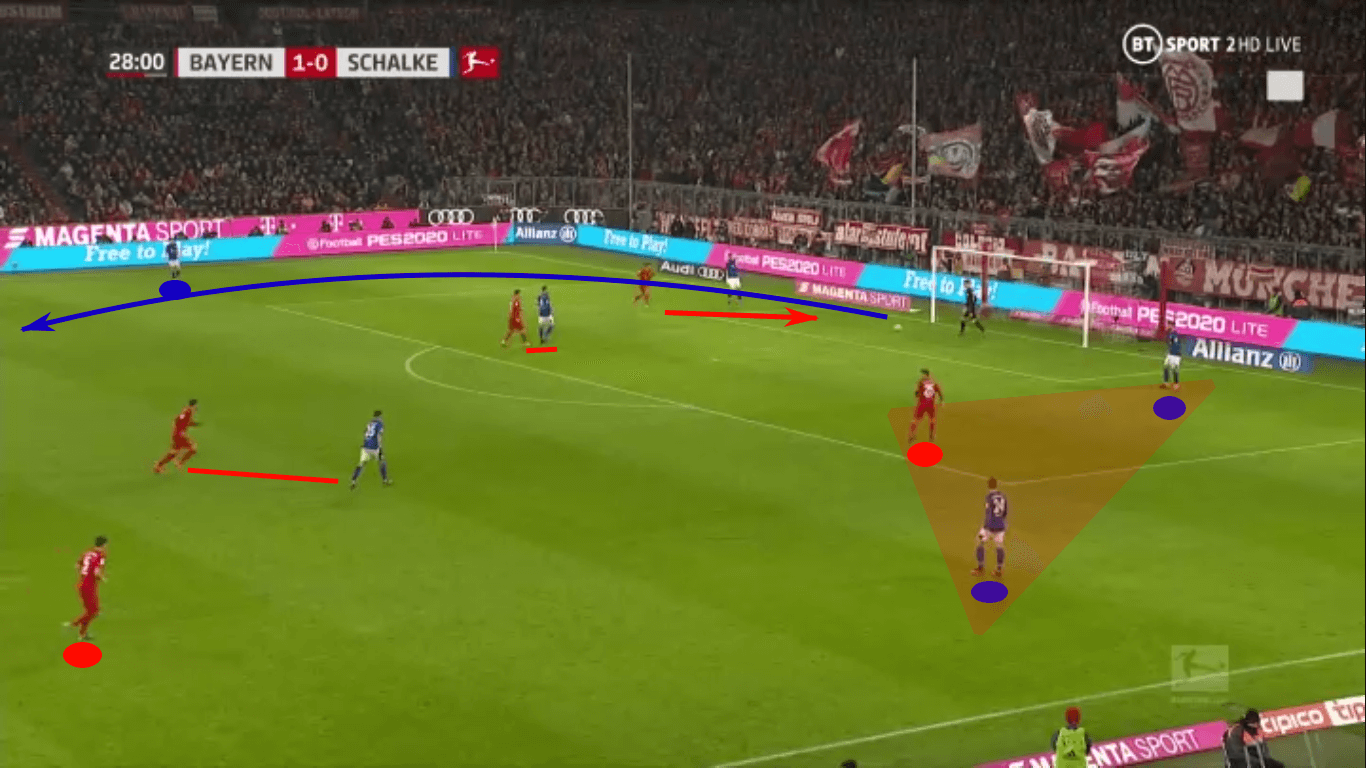
As Perišić pressured Schubert, the keeper opted to play long. Other than the long option, you can see he had 2v1 on the right-side of the pitch, but, with Thomas Müller lurking, any pass into that zone comes with a great deal of risk attached. In the clip, you can also see Benjamin Pavard cheating forward to pressure, much like we saw from Davies on the opposite flank.
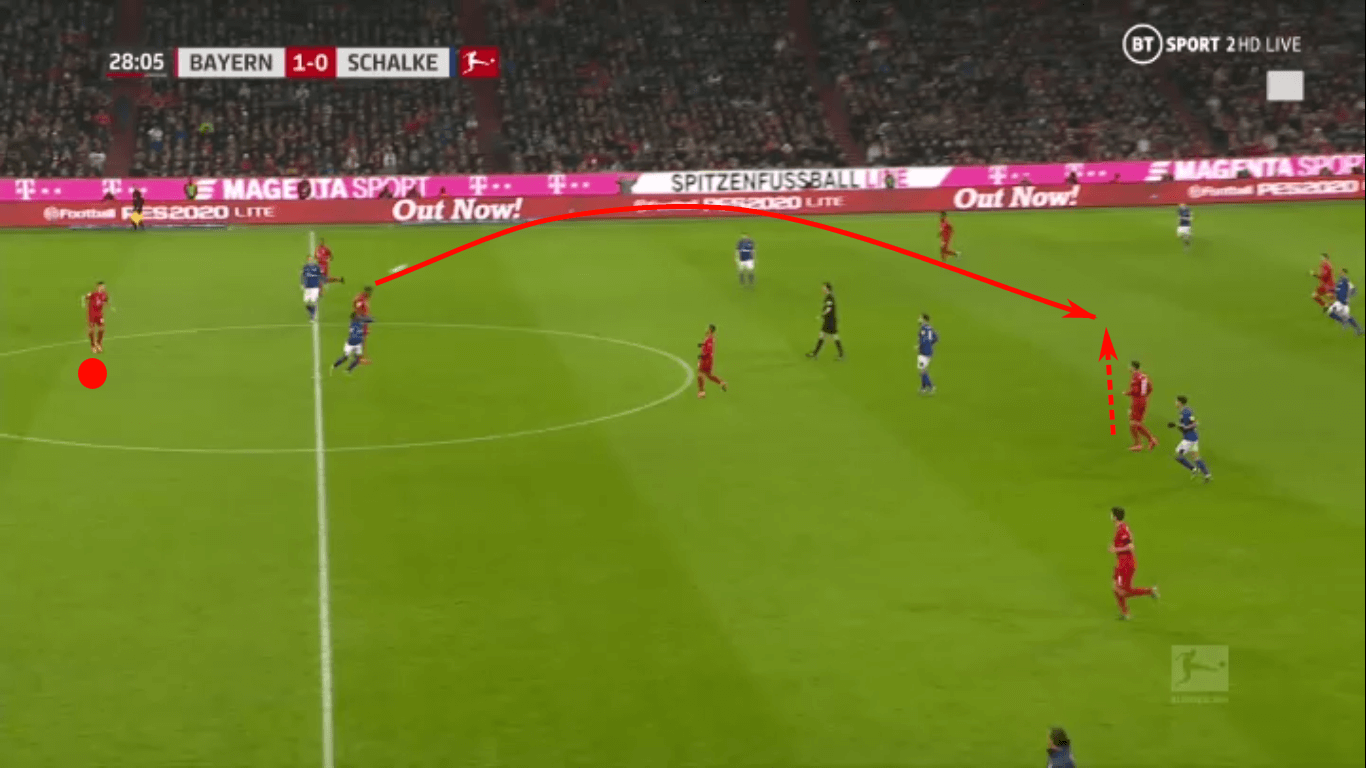
Jérôme Boateng won the header and Leon Goretzka won the second ball. In this sequence, Bayern effectively forced Schubert to play into Bayern’s strength, Boateng’s aerial battle against Rabbi Matondo. One other thing to notice is the positioning of Joshua Kimmich. He’s positioned behind Boateng, ready to clear the danger and giving Bayern a plus one at the back. His defensive coverage is critical to the success of the man-marking tactic.
The roles of counter-pressing and deep distributions
In open play, the transition from attacking to man-marking in a high press is entirely dependent upon the team’s ability to counter-press. The PPDA statistic is a great measure of a team’s ability to counter-press as it measures defensive actions (tackles, interceptions, challenges and fouls) in the highest 60% of the pitch. We want to know how effectively a side can win the ball before having to settle into a low block.
First and foremost, a high PPDA requires a mentally quick team that fluidly transitions for attacking to defending. Those moments immediately following a turnover are the key. Given the opposition time and space and they’ll bypass your numbers. Press them quickly and you can influence their attacking decision.
The nearest player should always go pressure. Some teams will send two, but the priorities are immediate pressure on the ball-carrier, identifying passing options and eliminating those options through man-marking. In general, the first defender will apply pressure while his teammates set up the man-marking tactic.
The role of the first defender is critical to the success of the press. Not only does he have to apply instant pressure on the ball carrier, but he also needs to get the opponent to put his head down, preferably to shield the ball and turn towards his own goal. Getting him to play backward into a scenario where his teammate can’t immediately play forward is ideal. As the first attacker is delayed and play goes negative, the defending team has time to initiate the mar-marking high press.
Real Madrid is one of the most effective man-marking high press teams in the global game. Though its 8.83 PPDA rates only seventh in La Liga, the objective is to force play all the way back to a goalkeeper or centre-back. Los Blancos want these players to make the initial distribution from a deep area of the pitch. Further, those negative passes allow the attacking team to gradually get its more expansive attacking shape. Once Madrid puts the onus on the goalkeeper or centre-back to play forward, the opposition generally has to send an intermediate or long-range pass. It should come as no surprise that Casemiro leads La Liga in interceptions. With 281 to his name, Madrid wants opponents playing into him and the centre-backs. Eliminating the passing lanes to the wide outlets is always a priority. As a team, Real only rate 13th in La Liga with 1,114 interceptions. That means Casemiro accounts for 25% of the side’s interceptions, showing why Zinedine Zidane wants the opponent to play into the Brazilian.
The central recovery through Casemiro greatly benefits the attack too. Since Madrid offers the widest players a cushion, any recovery sees them with a central numerical superiority, offering progressive passes (Madrid rank third in La Liga with 2,124 progressive passes) and an immediate route to goal.
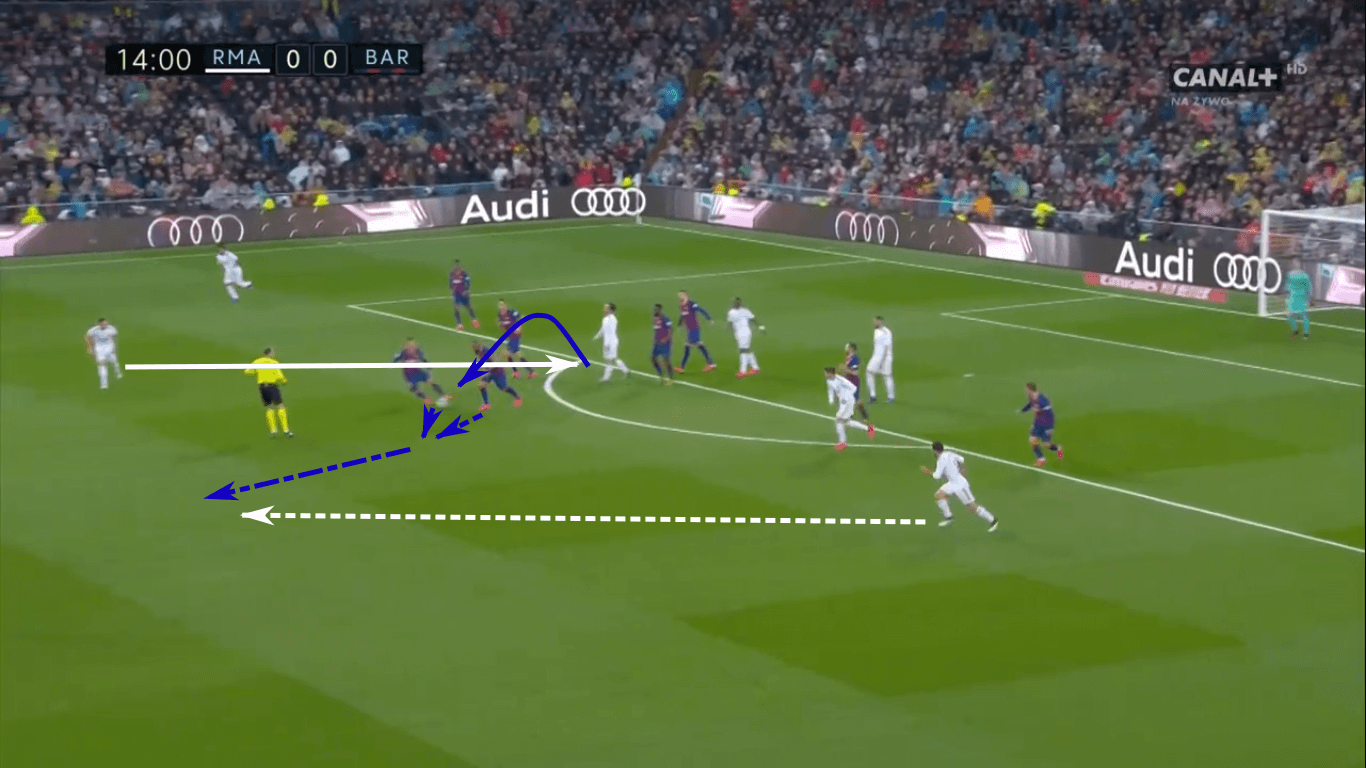
In the latest edition of El Clásico, Isco’s poor touch of a Toni Kroos pass popped the ball up in the air and was collected by Arthur. His touch led to a minor collision with Arturo Vidal, leading to the Chilean taking possession of the ball and driving up the pitch. Immediately after the turnover, Dani Carvajal, Federico Valverde, and Toni Kroos made a quick mental transition to counter-press.
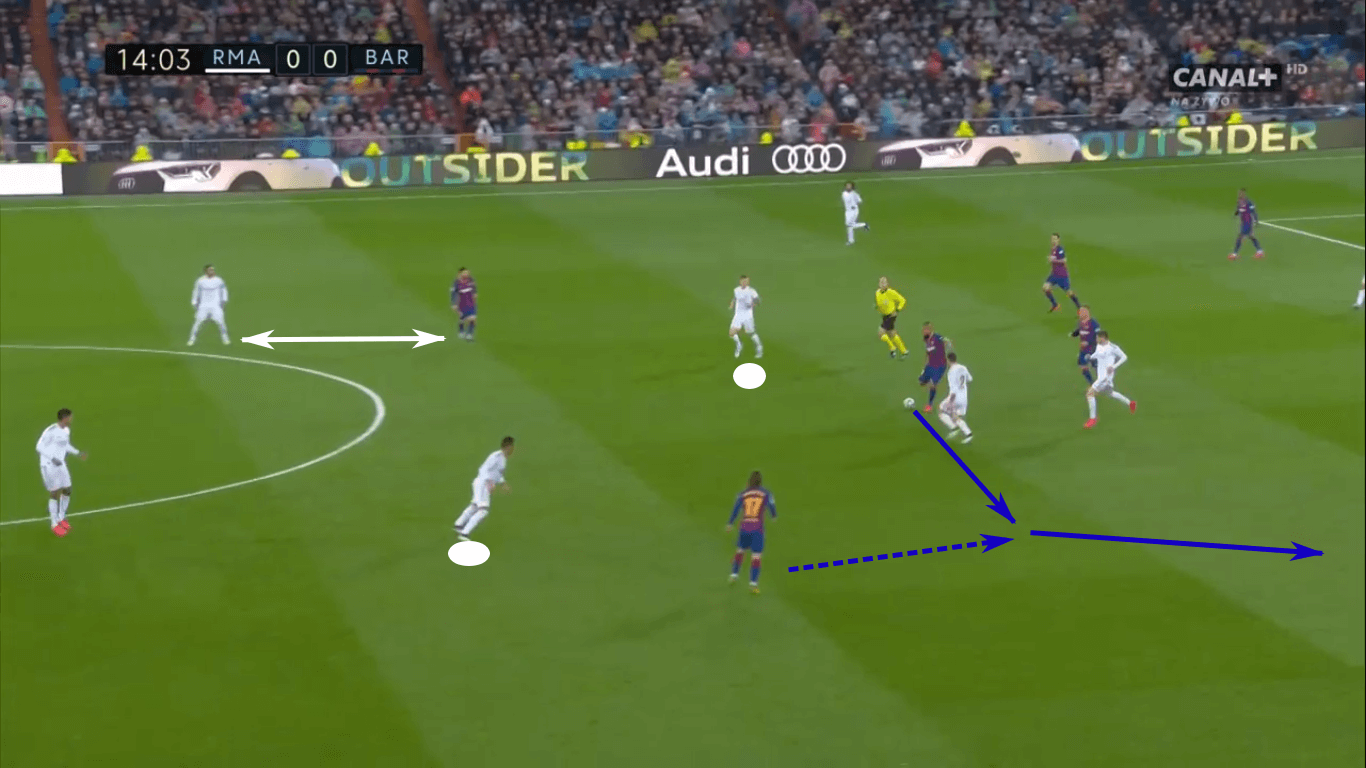
What we couldn’t see in the previous image is that Casemiro and Sergio Ramos were man-marking Antoine Griezmann and Lionel Messi in the event of a turnover. Raphaël Varane was in coverage, ready to use his blistering pace to win any ball played in behind. With Kroos cutting off the pass to Messi, Vidal could only play Griezmann or risk a negative turn into Madrid’s recovering defenders. He decided to play the Frenchman, but Carvajal’s tenacious recovery run allowed him to deflect the pass and send Griezmann backward, which is probably best as Casemiro was ready to claim the pass if it had been played to feet. Griezmann collected the pass and simply played negative before providing the Barcelona attack with some width.
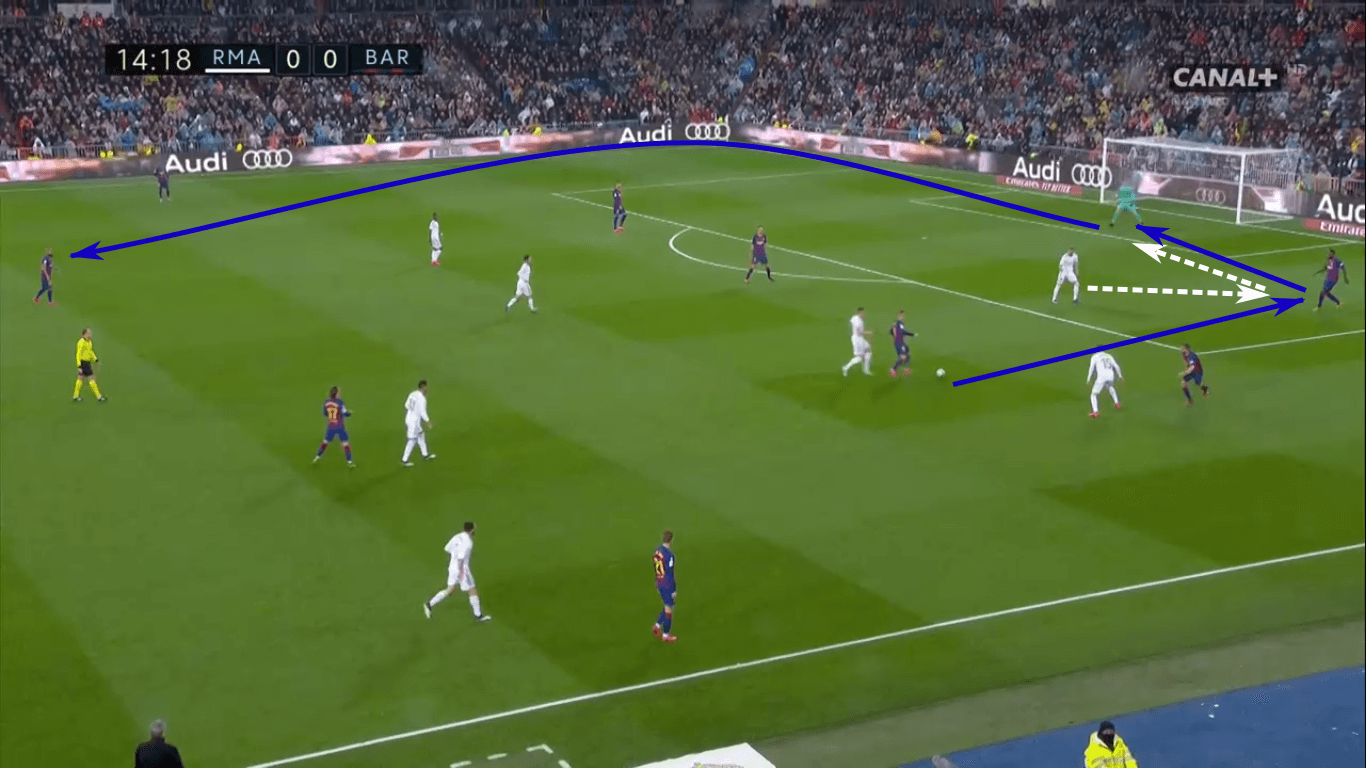
One thing to notice is that, after a successful counter-press forced Barcelona backward, each Real Madrid player found a mark, eliminating short and intermediate options. 15 seconds and several passes in the left-wing and half-space later, Barcelona was unable to progress due to the aggressive Real Madrid counter-press. Force to play backward in order to maintain possession, a pass to Samuel Umtiti was quickly pressured by Karim Benzema, forcing play to the feet of Marc-André ter Stegen. Again, Benzema was quickly on the scene, applying pressure to the goalkeeper while taking away the return pass to Umtiti. Ter Stegen looked to use his distribution ability to play forward to Vidal, sending a 35-metre pass in the central channel.
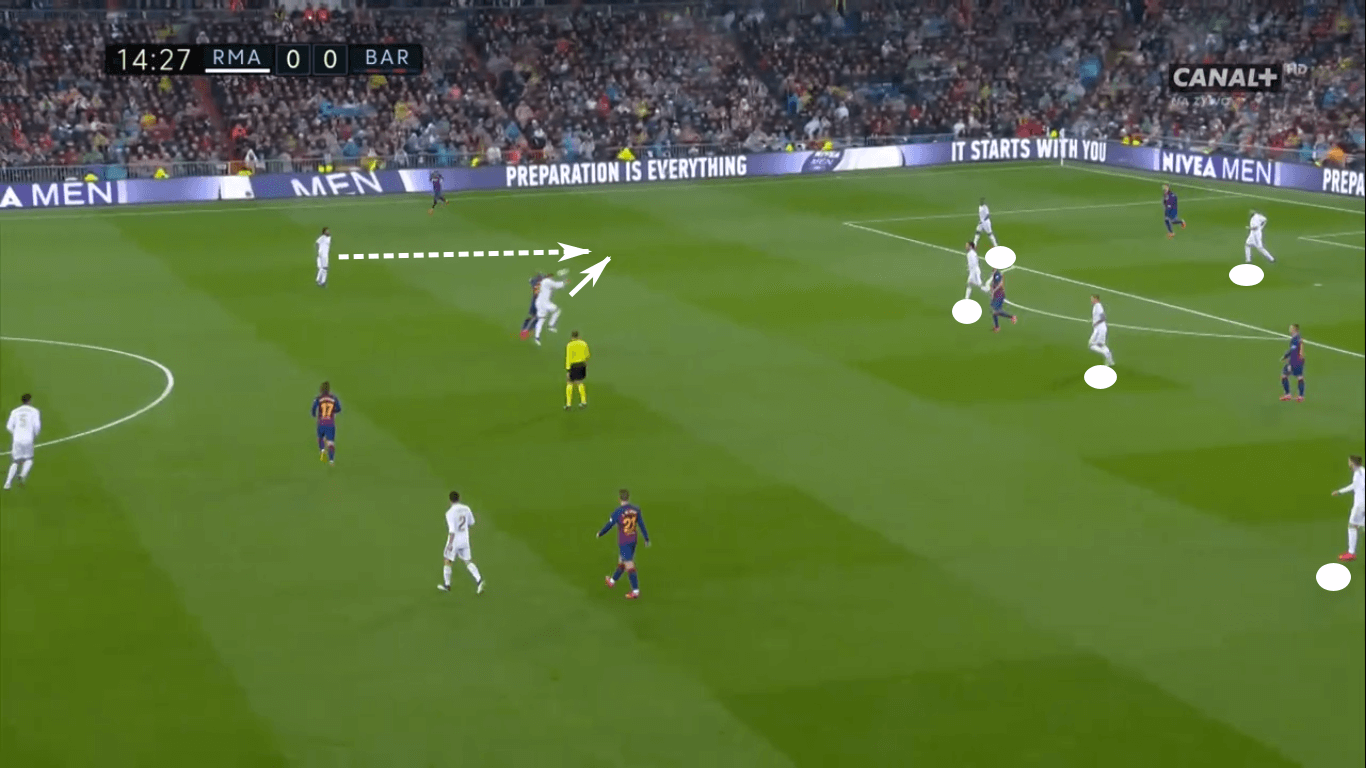
Given the distance of the aerial pass, Casemiro had plenty of time to respond, winning the header over the shorter Vidal. Now, and this is the critical moment for the Madrid attack, Marcelo, while man-marking Nelson Semedo, has the inside lane on his nearest opponent. Casemiro’s header and Marcelo’s positioning allowed the outside-back to collect the ball in space and attack the Barcelona backline. The wide players always want the inside positioning on their marks for two reasons: 1) defensive coverage if a teammate is beat and 2) winning the second ball with space to progress forward.
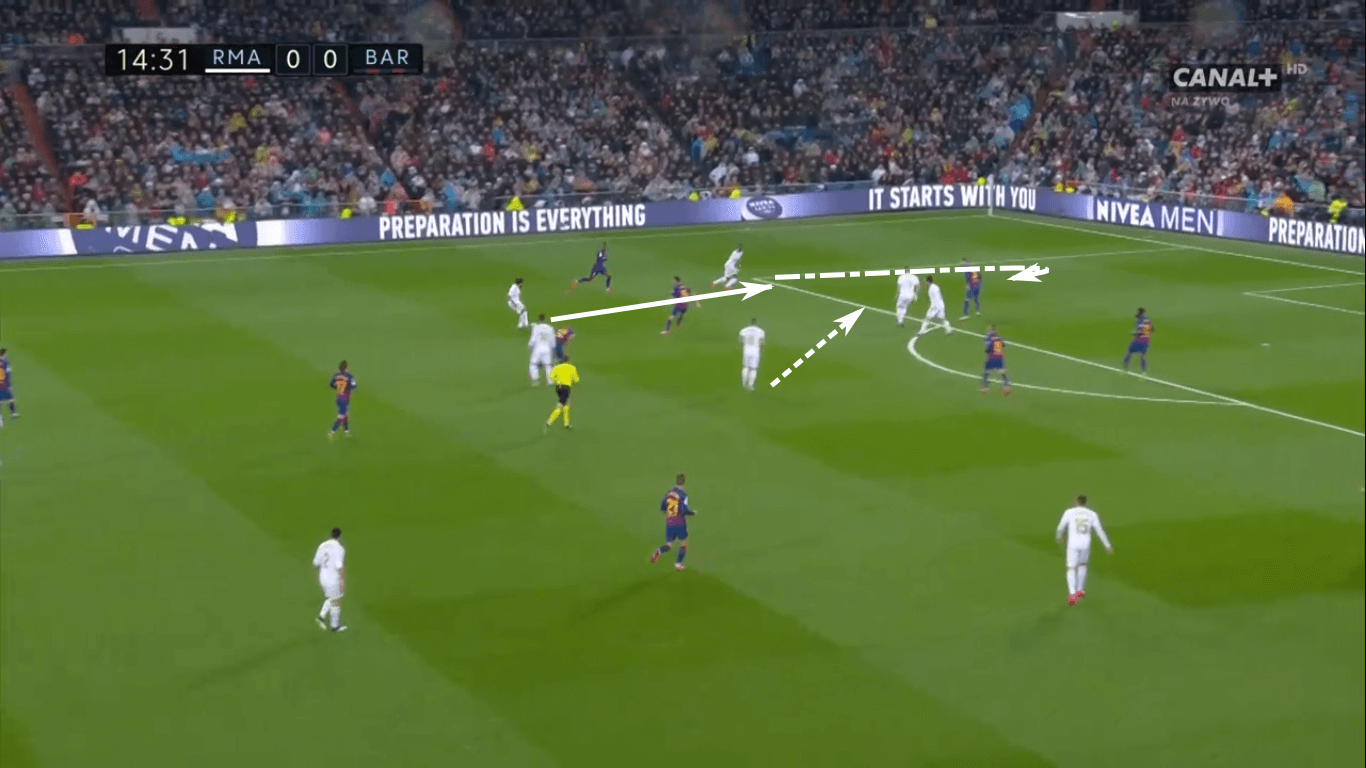
With Marcelo able to run at the backline and Semedo out of position to slow his attacking action, Barcelona’s players positioned between the ball and the goal had to quickly improvise to slow the Madrid attack. They were unable to do so as Marcelo picked out the run of Vinícius Júnior into the left-half space. With three Madrid attackers in that area, Barcelona was forced into a quick recovery into that section of the pitch. With the defenders’ momentum drawing them closer to the ball, Vinícius Júnior set the ball back to Kroos, who’s shot for inside the 18 was uncharacteristically poor, going well over the bar. Even still, Madrid’s quick counter-press, ability to force Barcelona backward, and patience to make ter Stegen play long from deep in his box opened up an excellent attacking opportunity. The nature of the turnover meant Barcelona was in an expansive attacking shape, allowing Real Madrid to run at a disorganized defence.
How a man-marking high press transitions to attack
One of the benefits of man-marking in the high press is the ease of transitioning to the attack. I alluded to Real Madrid’s tally of progressive passes. That’s enabled by the number of options available upon regaining possession. Since the current tactical trend is to attack the goal quickly with a limited number of passes and time, recovering the ball high up the pitch is a priority for the top teams.
Since all man-marking, high press teams offer the high and wide opposition players a little bit of a cushion, the defending team controls the middle and half-spaces. Whether the side has recovered the ball or simply won an aerial duel, it’s well placed to offer a penetrating pass or win the second ball. Controlling the second ball is a major priority. If the defending team can claim it, options for central penetration are immediately available.
If the attacking team manages to work the ball into the wings, one thing you’ll often see is the man-marking team try to bait a central pass. Again, since the centre of the pitch is largely inaccessible, those central passes are usually played into heavy traffic. Further, typically smaller attacking midfielders have to then hold possession against bigger defensive midfielders or a free centre-back. If the man-marking team is able to use this advantage well, a direct route to goal awaits them, generally in a numbers up situation.
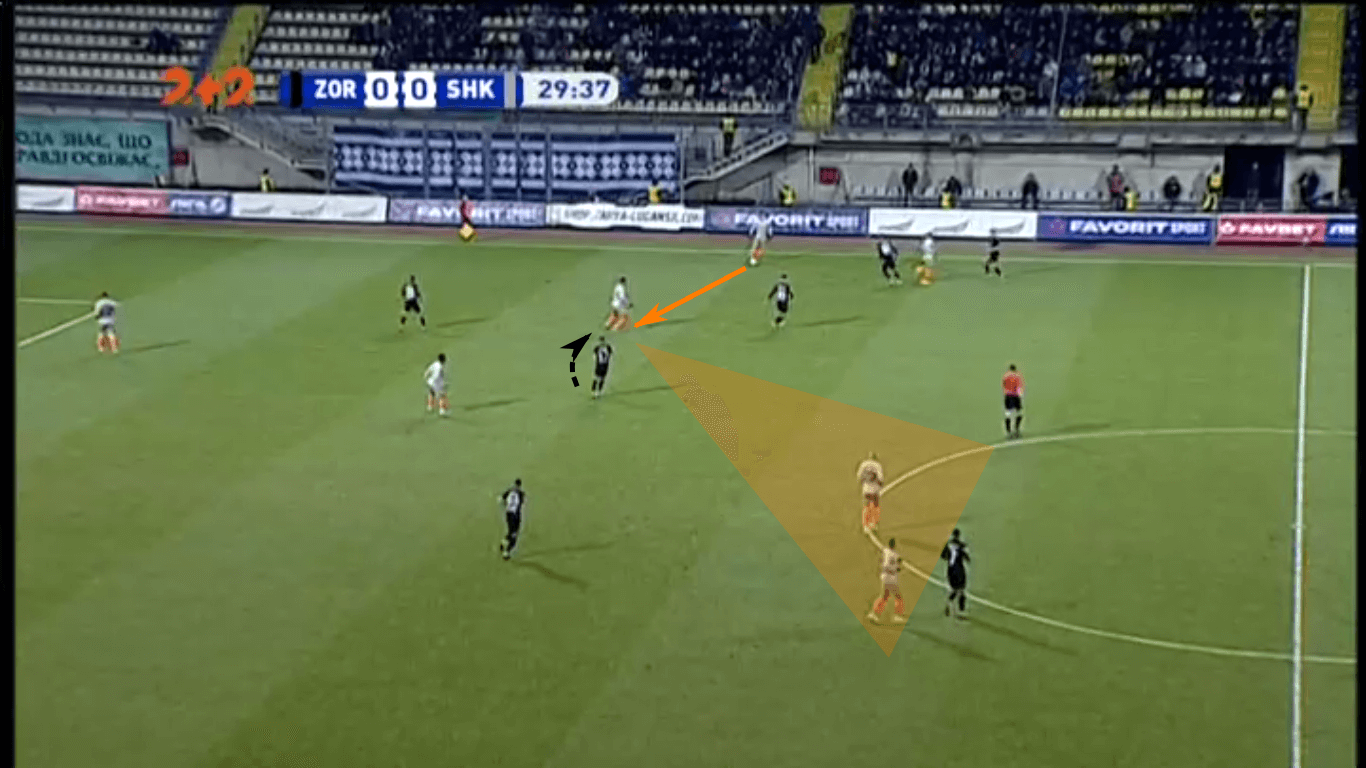
Now, over in the Ukrainian Premier League is a small club by the name of Zorya. In league play, no Ukrainian team can match the counter-pressing ability of this squad. The club averages a staggering 5.33 passes per defensive action. For comparison, Getafe is currently the best pressing team from a top-five league in Europe, averaging 7.13 PPDA. In this instance, an intense matchup against the Ukrainian powerhouse, Shakhtar Donetsk, saw the underdogs stay true to the club philosophy of high-pressing with man-marking.
After a turnover, Zorya quickly set out to counter-press the opponent. Funnelling play wide, Zorya appeared to give Shakhtar an outlet to the middle. With no other options available, the pass was made into a supposed 2v1 scenario. He took the bait.
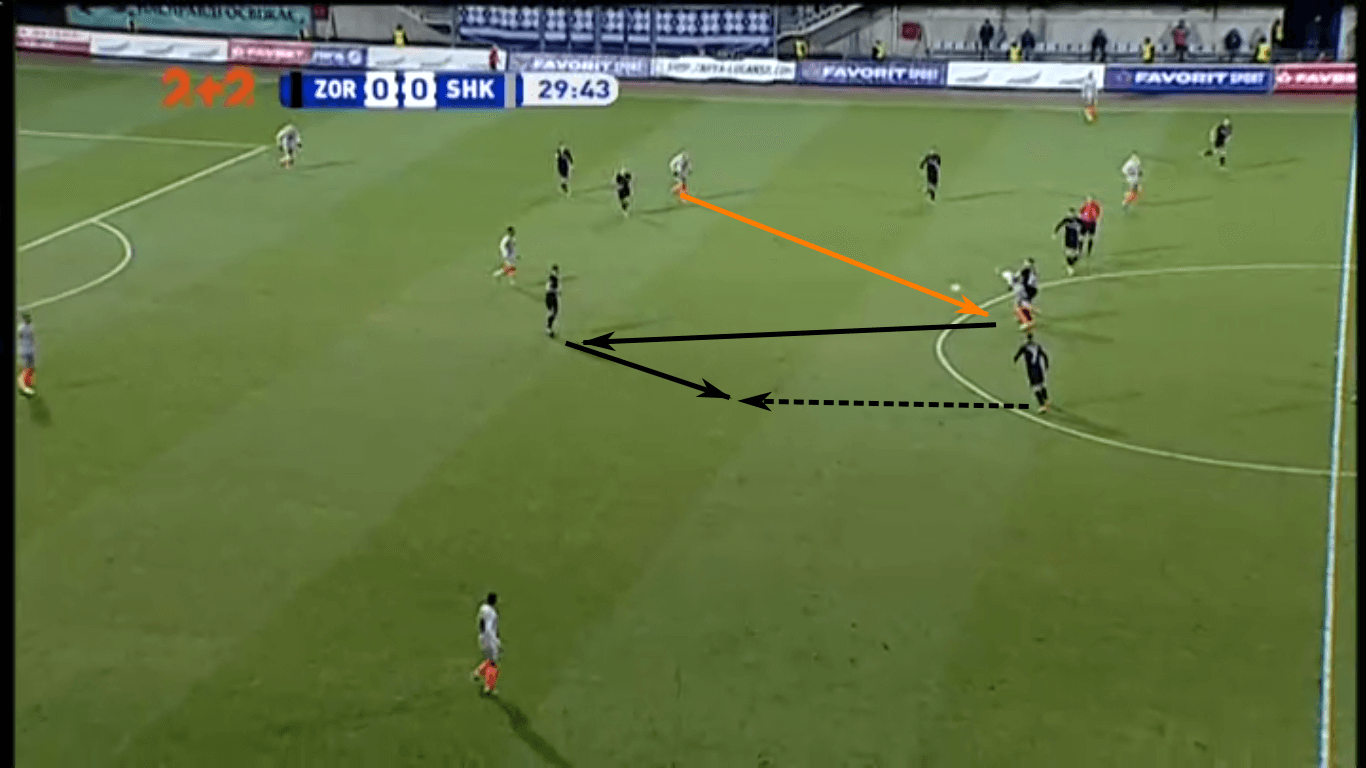
However, Joel Abu Hanna anticipated the central pass, stepping forward to poke the ball free to his teammate, Vladyslav Kabayev. He immediately set back to the oncoming run of Vladislav Kochergin.
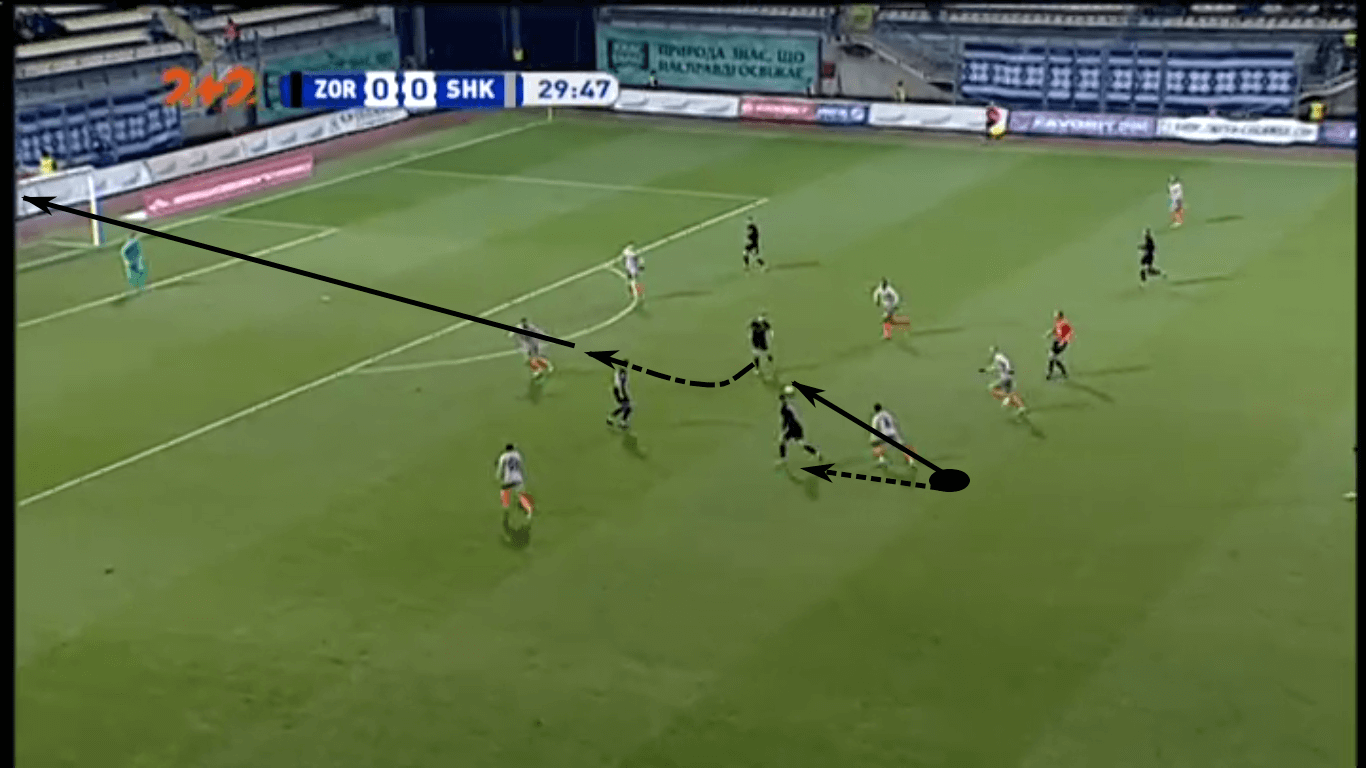
Kochergin ran at the first defender, pinning him to set up the pass to Bogdan Lednev. A nice turn into space opened up a shooting lane. His shot was parried by Ukrainian international, Andriy Pyatov, giving the home side a corner. One thing to notice in this sequence is the compact defending eliminating short options. Further, the pressure on the ball carrier limits his ability to play long, meaning the intermediate-range pass is the only option. With the backline ready to step forward, this pressing trap allows Zorya to attack centrally in numbers. A quick route to goal limits the defensive ability of Shakhtar and opens space for combination play and running at the defence. Had Lednev worked to pin the next defender and either play in a teammate or get into the box on the dribble, Zorya would have used its numerical superiority more effectively and created better shooting conditions.
When it goes wrong
You need a well-disciplined team to make man-marking work. The list of the best man-marking, high press teams in the world includes sides like Real Madrid, Bayern Munich, Getafe, LASK, Zorya and Leeds. You probably noticed that all those teams rank in the top four of their league, at least at the time of writing. One reason for the effectiveness of the tactic is that it pits a superior athlete and player against a lesser opponent. In cases like Getafe’s, what makes the system work is intelligent fouling. The side leads La Liga with 493 fouls and 90 yellow cards. If an opponent beats the first wave of pressure, they won’t have a chance to beat the second. Getafe’s hard-nosed approach also sees it lead La Liga, and all the top five leagues in Europe, with a 7.13 PPDA. Systematic fouling is a necessary part of the man-marking, high press approach.
What breakdowns have to occur before the foul? Glad you asked. First and foremost, the immediate threat of losing a 1v1 battle. Opponents cannot turn on a defender or receive behind them. Second is losing the first or second ball. Aerial dominance and numbers to claim the second ball are critical. Lose those end the opposition has a chance to play in behind.
Another issue is allowing a penetrating central pass that allows the opponent to turn and play a wide outlet. Since these man-marking systems cheat centrally knowing they have time to pressure a long, any wide pass generally breaks pressure and allows the winger to run at or play behind the backline.
Finally, creative movements and patterns off the ball while the attacking team connects short passes can cause issues. If even one player switches off and loses track of his mark, the whole system can be blown wide open. If any of these situations occur, a tactical foul is the best means of preventing a dangerous ball behind the backline.
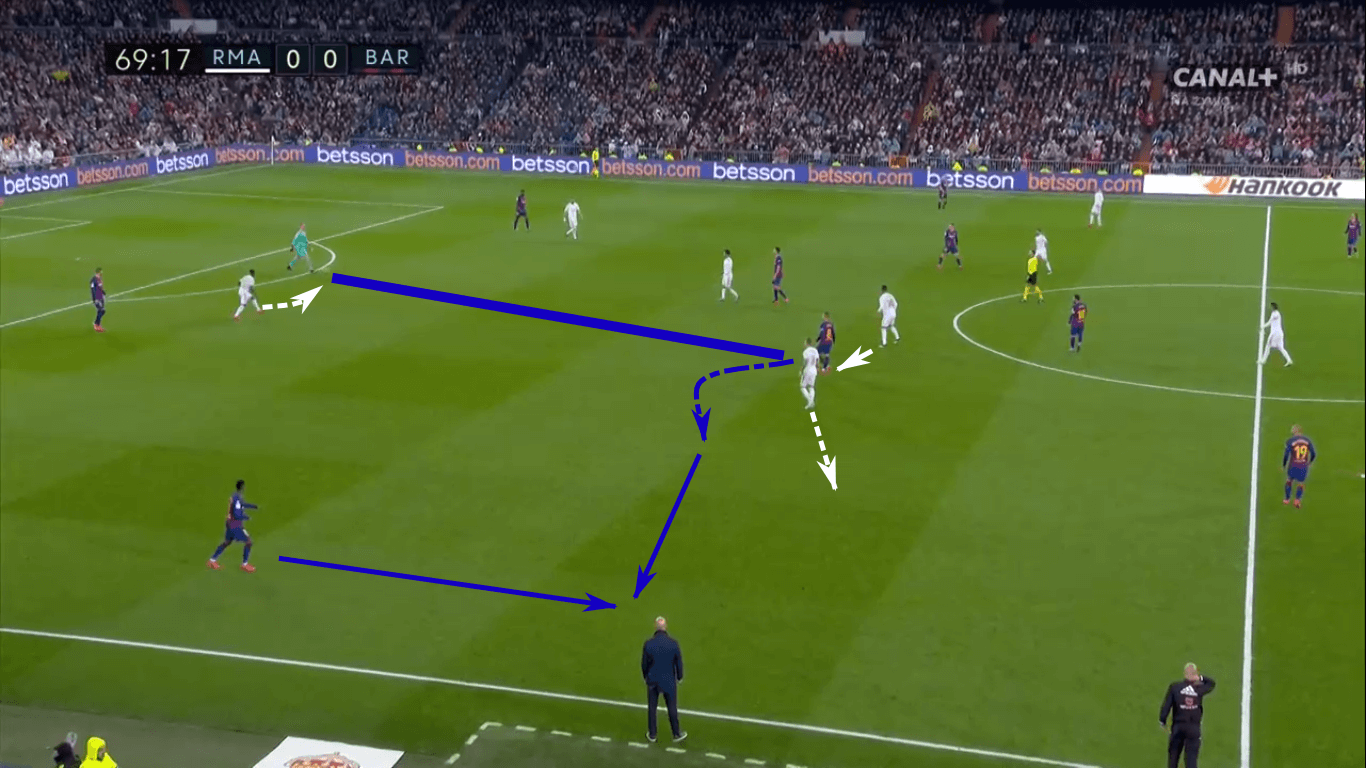
Going back to El Clásico, ter Stegen had more success breaking down the Real Madrid defence after the intermission. One of the reasons is that he managed to receive the ball higher up the pitch in the very centre of the field. With more time and space to play out, he was able to utilize his distributing abilities, often feigning long-range distribution out wide. That moved players away from the centre of the pitch. Barcelona would then play inside before quickly playing wide. Before moving to the next picture, notice how Messi has dragged Ramos into the midfield and the ter Stegen faking a wide pass created central space for Arthur. The switch from Kroos and Casemiro wasn’t clean, so the Barcelona midfielder received more time as a result of the error.
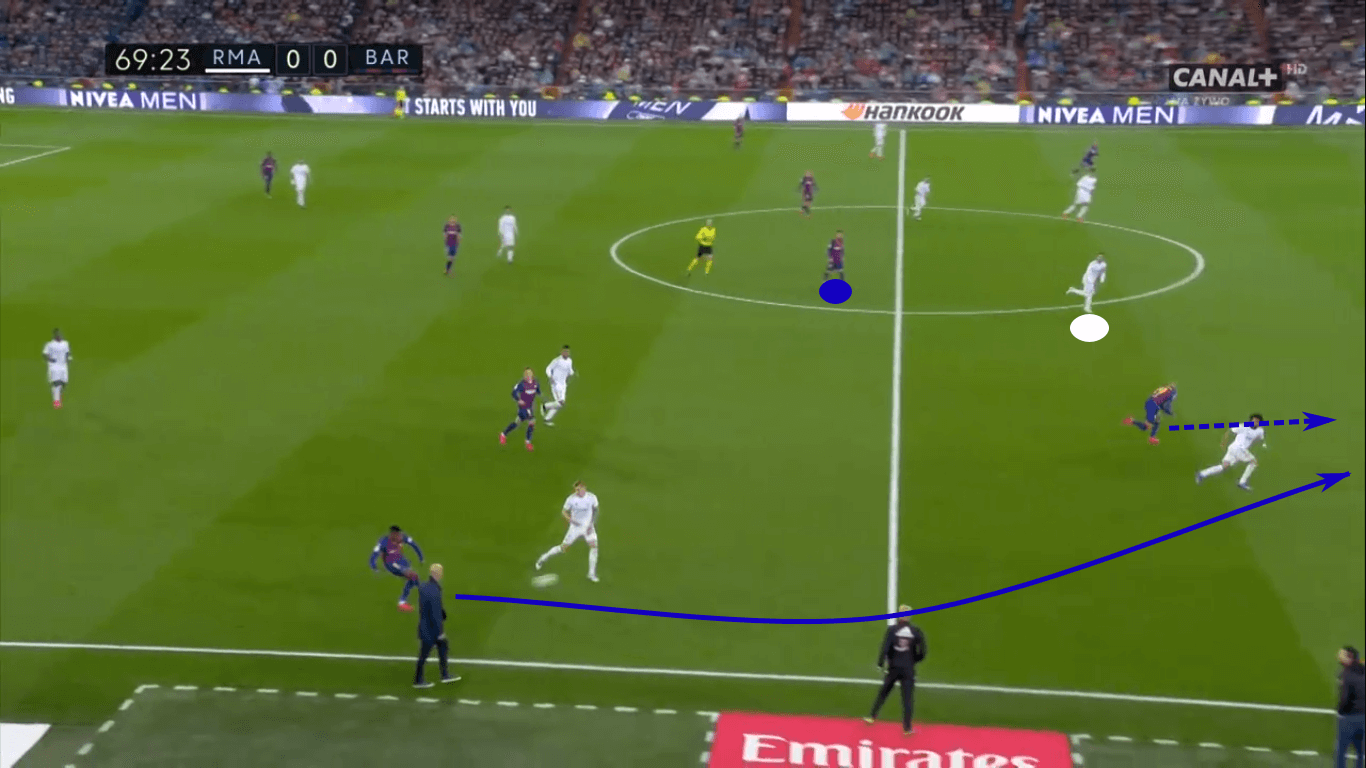
As Semedo received the pass, he took a touch and then played Martin Braithwaite behind the defence with a sumptuous curling effort. Notice Ramos is still trying to recover his ground. He’s behind the play and unable to help Marcelo. Varane was busy man-marking on the right, meaning Braithwaite was able to use his speed without concern of running into a cover defender.
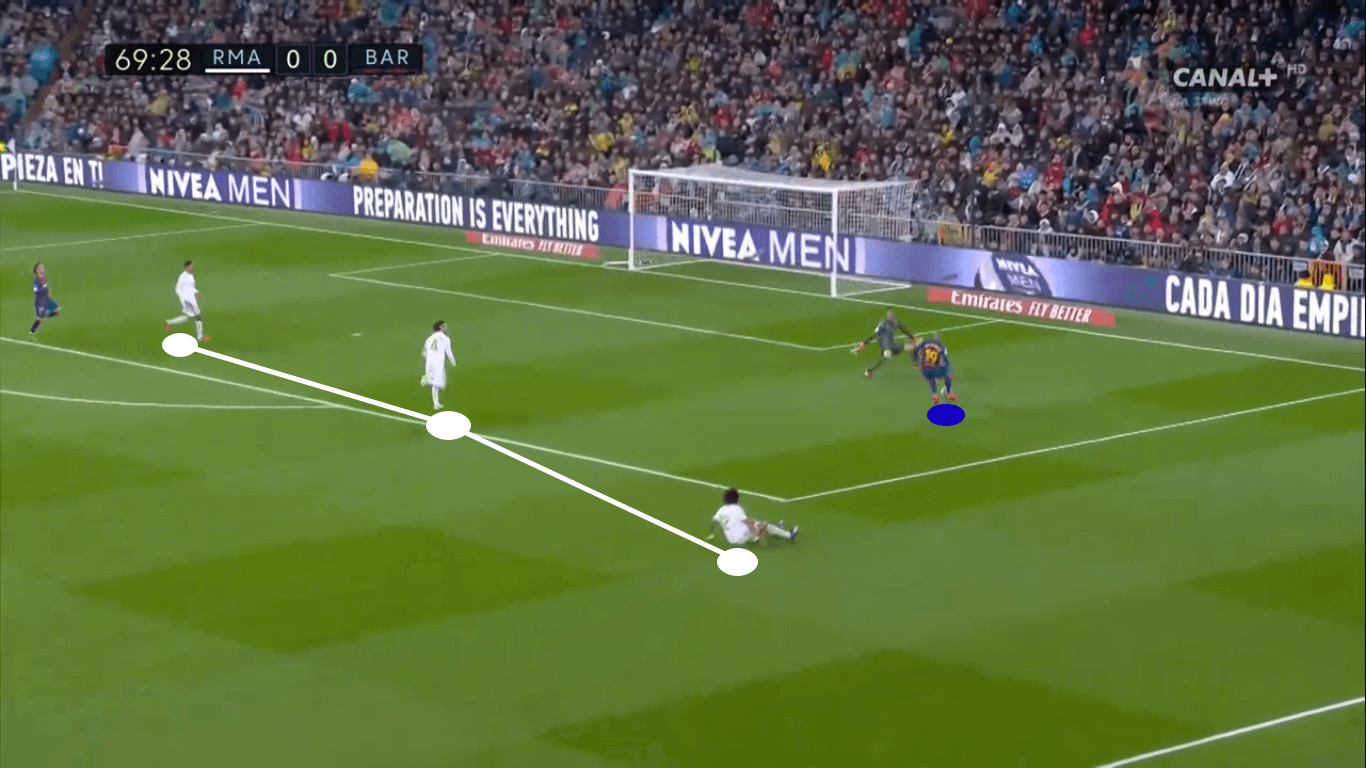
Courtois came out and made the angle tight, saving Real Madrid, who would go on to score the winner in the following minutes. Still, with Braithwaite behind the Madrid backline, this goes to show the necessity of forcing the initial distribution from a deeper area and of the plus one in defence. Without it, one pacey player can break the system.
After the pass out of pressure
Let’s say the opposition does make a pass out of pressure and connect with a higher positioned player, but the defending team has the numbers back to cope with the lapse. In this instance, winning the ball is still an option, so a tactical foul isn’t necessary. What needs to happen is the closest defender needs to go press while funnelling away from the opponent’s nearest passing options. If he’s leaving an attacker, his run should cut out the passing lane as well.
If numbers and the defenders’ positioning enable the first defender to pressure with adequate coverage, he should apply pressure. If the nearest defender hasn’t quite arrived, perhaps he’s making a recovery run; the defender should delay the attack while awaiting help. If the nearest help is a recovery defender, turning this 1v1 into a 2v1 is beneficial.
The conditions surrounding the attack are highly variable, so it’s impossible to address every scenario, but, if possible, funnelling the attack into the wings is the ideal route is the first wave of defence is broken. Reduce the opposition’s options and attempt to trap them out wide. If the opponent is able to win a 1v1 dribbling duel, fouling is the obvious solution. Otherwise, limiting his passing options and range of ball striking options makes play more predictable. If he’s stuck on the wing, he only has so many options to play out of pressure. If the defending team has numbers behind the ball, forcing a rushed, undesirable action from the attacker is the best-case scenario.
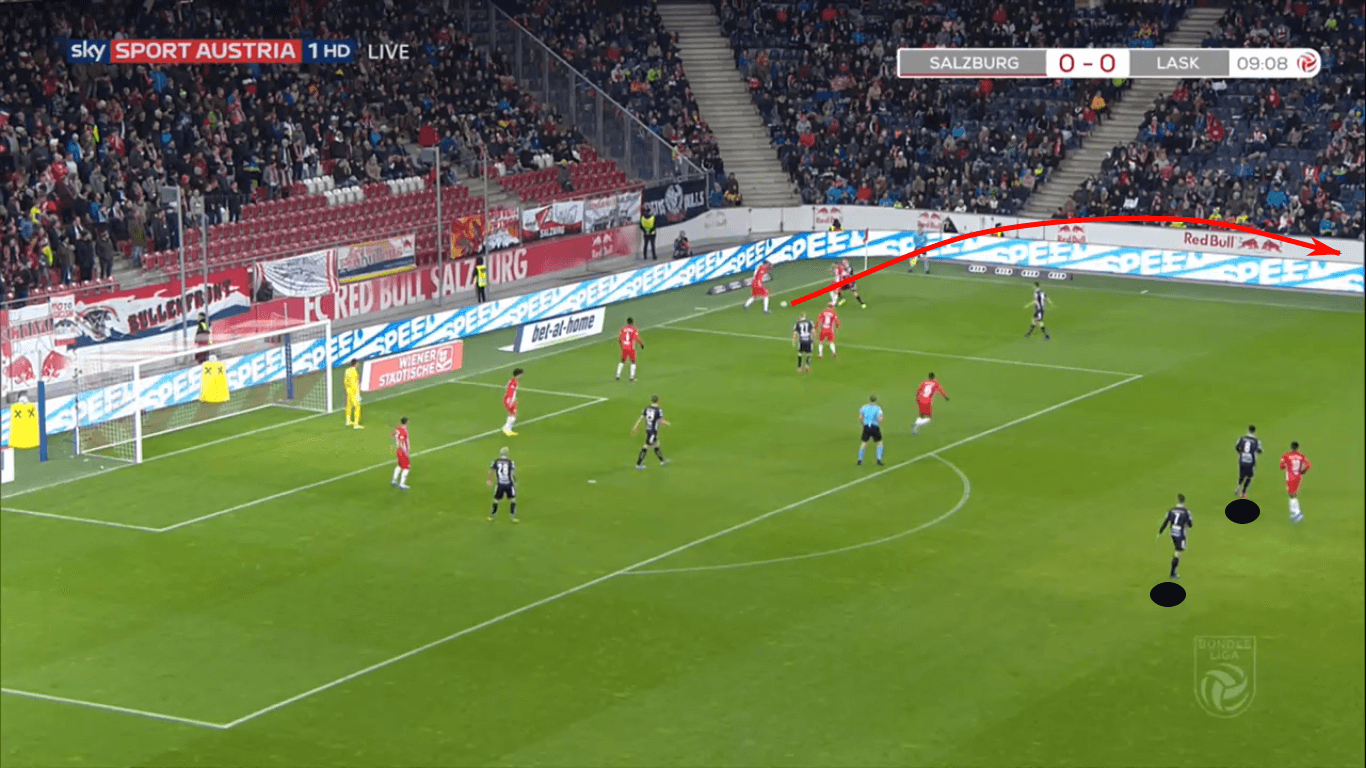
In the Austrian Bundesliga’s biggest match of the season, Red Bull Salzburg hosted LASK with the winner taking control of the league table. This scenario saw LASK lose possession deep in the Salzburg end. Facing heavy pressure, Maximilian Wöber decided to bypass the LASK lines, playing the pass high and wide. You can make an argument that a pass to Enock Mwepu, who’s between the LASK lines at the corner of the box, is the better option. Even in that scenario, he’d face heavy pressure from Peter Michorl. With Wöber off-balance, there’s no guarantee he’s able to put enough pace on the pass to give Mwepu the necessary conditions for a successful action.
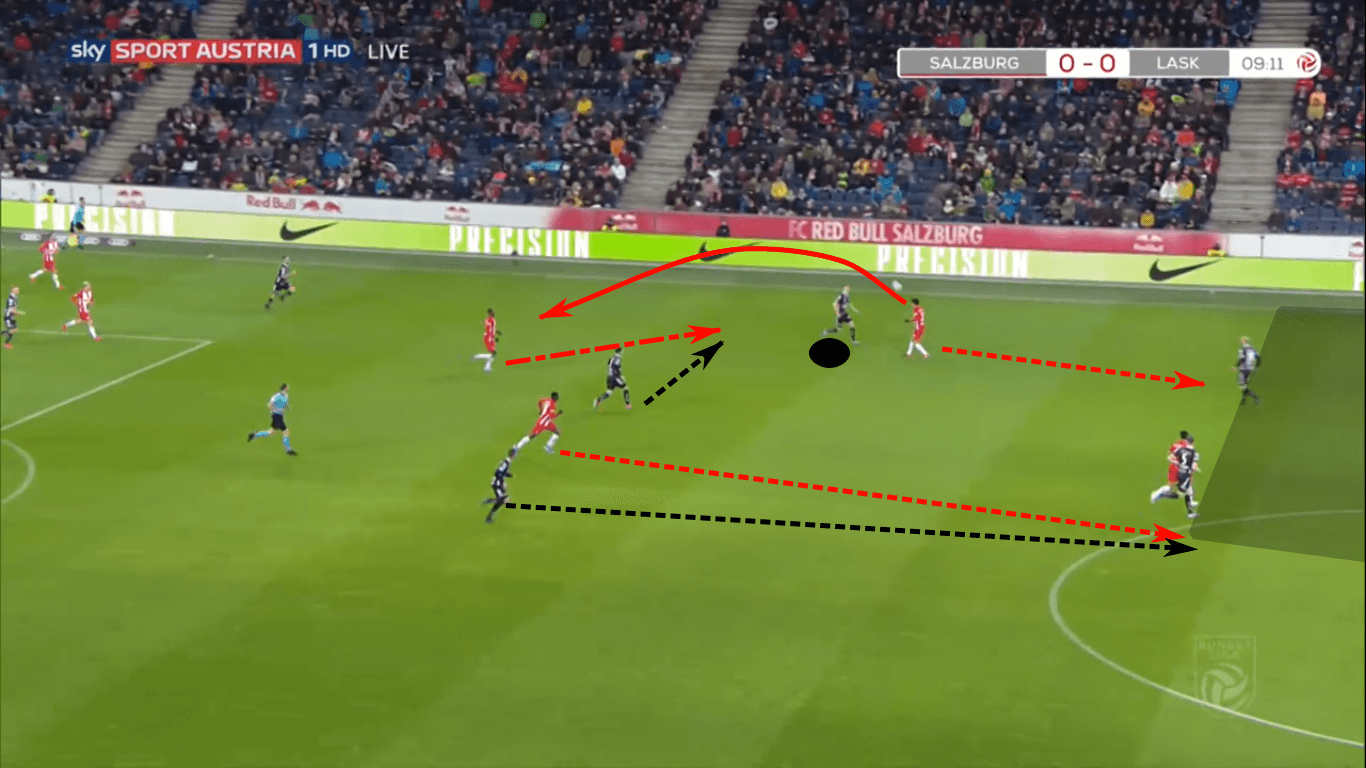
Masaya Okugawa claimed the pass and headed back to the run of Mwepu. Michorl was quick to close him down, funnelling the Zambian wide and preventing the ball over the top to Hwang Hee-Chan. Notice Patson Daka’s run forward. With Hwang moving into the left-half space, the central channel opened up for Daka. If not for the immediate pressure on the ball, Mwepu would have played Daka through to goal. Great pressure on the ball carrier delayed the attack and allowed the LASK midfield to recover its ground.
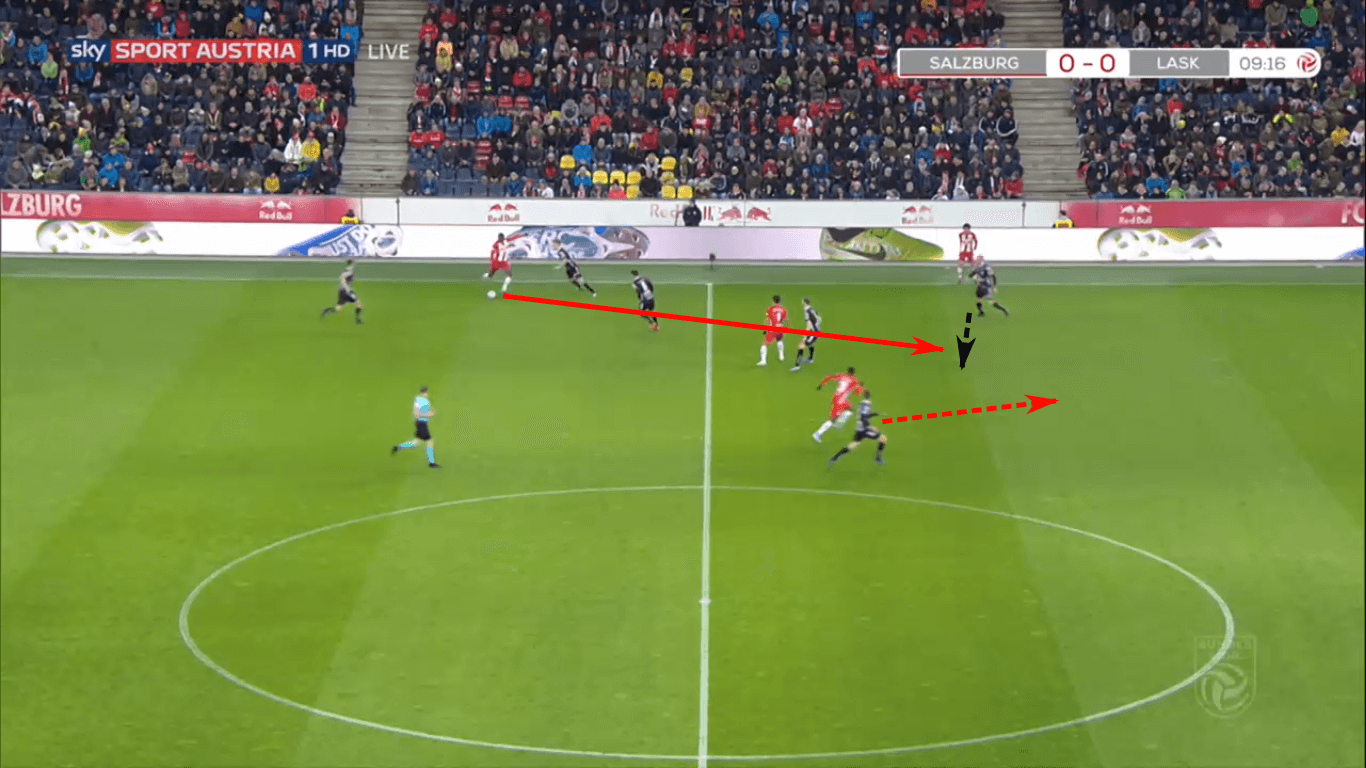
LASK is still in recovery mode and trying to contain the Salzburg attack. It no longer has the plus one at the back, but the key is close proximity to Mwepu. Denying him the time and space to play his top option with the right technique was critical. Further, he really only has one option; the through ball to Daka. With Philipp Wiesinger intelligently taking away the touchline pass to Okugawa, Gernot Trauner was able to cheat centrally in anticipation of the through ball. That movement led to his interception, starting the next wave of the LASK attack. Even though LASK’s lines were bypass with the first ball and Salzburg controlled the second, a commitment to recovery and pressure on the ball carrier denied Red Bull the opportunity to play the killer pass. With the attack suitably delayed and attacking options restricted, LASK made the play more predictable and was able to claim the attempted through ball.
Conclusion
As this analysis shows, the upside of man-marking in a high press gives the top clubs a significant edge. When the press works, routes to goal are more open and the side will have a numerical superiority while advancing to the opposition’s box. Additionally, a strong counter-press and focused approach after a loss allows the man-marking sides to effectively force the opposition to initiate the attack from weaker starting points.
There are some downsides to man-marking in a high press. As with any man-marking system, the first defender cannot afford to lose his individual battle. If that happens, the opposition can have a run at the next line of defence. Since that line is also man-marking, the opposition can attack in a numerical superiority or even numbers (supposing the backline has maintained its plus one). However, we’ve discussed some of the solutions applied by the top man-marking teams. Whether funnelling play to the wings, delaying the attack or fouling, there’s a way out of most problems.
With the game favouring teams that create direct, quick-strike opportunities to goal, coaches must look to create attacking conditions from defensive dominance. Man-marking in a high press is currently one of the most effective means of creating ideal attacking opportunities. Most teams struggle to overcome the press and, even if they do, a tactical foul will nullify the attack. Given the huge upside of the man-marking high press model and limited downside, expect more clubs to apply this defensive tactic in the near future.




Comments